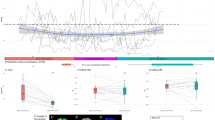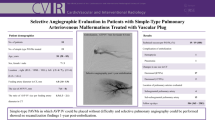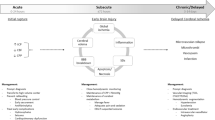Abstract
Background
Cerebral infarction after pulmonary resection is a minor but critical complication. We report a rare case of postoperative complication of Wallenberg syndrome caused by cerebral infarction in the posterior inferior cerebral artery after the left upper lobectomy.
Case presentation
A 72-year-old man developed cerebral infarction 2 days after a left upper lobectomy for lung cancer. Magnetic resonance imaging indicated right vertebral artery occlusion following an early ischemic area on the right lateral side of the medulla oblongata and cerebellum. Contrast-enhanced computed tomography revealed no thrombus in the left superior pulmonary vein stump. The patient was diagnosed with Wallenberg syndrome, and prompt anticoagulation therapy was initiated. The patient was discharged and transferred to another hospital for rehabilitation on postoperative day 16.
Conclusions
We present a rare case of Wallenberg syndrome occurring in the posterior inferior cerebral artery area due to vertebral artery occlusion after lobectomy. Because cerebral infarction of the posterior circulation has many similar symptoms due to the side effects of anesthetic drugs, careful physical examination is required to determine Wallenberg syndrome.
Similar content being viewed by others
Background
Cerebral infarction is a rare but critical complication of pulmonary resection. Thrombus at the pulmonary vein stump or the left atrial appendage following atrial fibrillation often leads to cerebral infarction in the area of the middle cerebral artery. The causes of cerebral infarction are divided into thrombosis and embolism; most cerebral infarctions caused by embolism occur in the anterior cerebral circulation from the middle cerebral artery. Herein, we report a rare case of postoperative cerebral infarction representing Wallenberg syndrome that occurred in the posterior inferior cerebral artery due to vertebral artery occlusion.
Case presentation
The patient was a 72-year-old male. He had a history of hypertension, chronic obstructive pulmonary disease, pneumothorax, and appendix cancer. He had smoked 30 cigarettes daily for 50 years but had no history of arrhythmia or cerebrovascular disease. His family doctor identified an abnormal shadow on the chest radiograph. Computed tomography (CT) revealed a tumor in the left upper lobe of the lung with no hilar or mediastinal lymph node swelling (Fig. 1a). Head CT showed slight calcification in the right vertebral artery (Fig. 1b). An 18-fluoro-2-deoxyglucose-positron emission tomography scan revealed that the maximum standardized uptake value at the center of the tumor was 10.4. CT-guided biopsy confirmed the diagnosis of lung adenocarcinoma (cT1bN0M0, cStageIA2, as defined by the 8th Edition of TNM classification of lung cancer).
The patient underwent video-assisted thoracoscopic left upper lobectomy and upper mediastinal lymph node dissection (ND2a-1). The left superior pulmonary vein was divided by using a linear stapler. The patient developed atrial fibrillation on the day after surgery and was treated with landiolol hydrochloride and continuous intravenous heparin infusion. At noon on postoperative day 2, the patient complained of dizziness and dysphagia. While his consciousness level was Japan Coma Scale 0, speech disturbances, ptosis of the left labial angle, hoarseness, and ataxia of the right upper and lower limbs were noted. He had a National Institutes of Health Stroke Scale score of 3. The patient underwent contrast-enhanced chest CT and emergency magnetic resonance imaging after the removal of the epidural catheter. Magnetic resonance imaging indicated an early ischemic area on the right lateral side of the medulla oblongata and cerebellum (Fig. 2a). Magnetic resonance angiography revealed right vertebral artery occlusion, which was not seen preoperatively (Fig. 2b–d). Contrast-enhanced chest CT revealed no evidence of thrombus in the stump of the left superior pulmonary vein (Fig. 3). The patient was diagnosed with Wallenberg syndrome, which occurred in the posterior inferior cerebral artery, and anticoagulation therapy with heparin and edoxaban was started. The repetitive saliva swallowing score test value was 3 times/30 s, and videoendoscopic evaluation of swallowing indicated right vocal cord paralysis. On postoperative day 9, a follow-up brain CT showed hemorrhagic infarction in the cerebellum (Fig. 4), but no new adverse events occurred. The patient was discharged and transferred to another hospital for rehabilitation on postoperative day 16.
a Diffusion-weighted magnetic resonance image of the brain showing high-intensity signals in the medulla oblongata and the right cerebellum (yellow arrows). b Magnetic resonance angiography indicated occlusion of the right vertebral artery (yellow arrow). c The right vertebral artery can be seen on the preoperative head magnetic resonance image (yellow arrow). d Magnetic resonance imaging at the onset of cerebral infarction indicating a loss of signal in the right vertebral artery (yellow arrow)
Discussion and conclusions
This is a rare case of Wallenberg’s syndrome after pulmonary resection. The frequency of Wallenberg syndrome is estimated to be approximately 2% in acute cerebral infarction [1], and Wallenberg syndrome presents a variety of neurological abnormalities that are difficult to diagnose [2]. The main complaints of Wallenberg syndrome are similar to the side effects of general anesthesia, such as dizziness, postoperative nausea, and vomiting. However, ataxia and dysarthria do not usually appear as side effects of anesthesia, while dizziness and nausea suddenly appear in patients after general anesthesia, especially after the left upper lobectomy. Hence, special attention and detailed physical examination are required in cases of Wallenberg Syndrome.
A literature search was performed in January 2022 using PubMed, with the following terms: (“lung cancer” OR “NSCLC”) AND (“surgery” OR “lobectomy”) AND “Wallenberg.” We found 31 articles on the criteria worldwide; however, no case of Wallenberg syndrome after pulmonary resection was discovered. By searching with the terms: (“lung cancer” OR “NSCLC”) AND (“surgery” OR “lobectomy” OR “pulmonary resection”) AND “cerebral infarction,” we performed a literature review of cases of cerebral infarction after pulmonary resection, in which the site of cerebral infarction could be identified (Table 1) [3,4,5,6,7,8,9,10,11,12,13]. Most of them had a cerebral infarction in the region of the anterior circulation, such as the internal carotid artery and the middle cerebral artery, and only two cases were in the region of the posterior circulation. To the best of our knowledge, this is the first reported case of Wallenberg syndrome following pulmonary resection.
The incidence of cerebral infarction after lung surgery is reported to be 0.3–0.6% [14, 15]. However, patients undergoing left upper lobectomy have a higher frequency of cerebral infarction than those undergoing resection of other lobes. Ohtaka et al. reported that thrombosis in the last superior pulmonary vein stump after left upper lobectomy was a common complication, and it was one of the causes of cerebral infarction [16]. Kimura et al. reported that patients with cerebral infarction after pulmonary resection experienced atrial fibrillation postoperatively at a high frequency [3]. In our case, no pulmonary vein stump thrombus was found on CT, but new atrial fibrillation occurred and returned to sinus rhythm before the onset of cerebral infarction. Although ultrasound assessment of carotid arteries and echocardiography was not performed in this case, a preoperative CT scan showed mild calcification in the right vertebral artery, suggesting stenosis at the same site compared with other arteries leading to the brain. We speculated that an embolus caused by atrial fibrillation lodged in the constricted right vertebral artery.
Generally, the administration of recombinant tissue plasminogen activator (rt-PA) must be considered a new acute cerebral infarction in hospitals [17]. However, in most patients after surgery, intravenous administration of rt-PA is contraindicated, particularly after pulmonary resection, because serious hemorrhagic complications may occur. Second, it was necessary to assess the possibility of endovascular treatment. One of the indications for endovascular treatment is acute occlusion of the internal carotid or middle cerebral artery; however, there have been no randomized controlled trials for vertebral artery occlusion. A meta-analysis of 17 patients who underwent endovascular treatment for vertebral artery occlusion showed a high resumption rate of 80% [18]. We hope safe endovascular treatment of the posterior circulatory system can be established.
In conclusion, we presented a rare case of Wallenberg syndrome after pulmonary resection in the posterior inferior cerebral artery area due to vertebral artery occlusion after lobectomy. Because cerebral infarction of the posterior circulation shows many similar symptoms due to the side effects of anesthetic drugs, careful physical examination is required to determine Wallenberg syndrome.
Availability of data and materials
Data sharing is not applicable to this article, as no datasets were generated or analyzed during the current study.
Abbreviations
- CT:
-
Computed tomography
- rt-PA:
-
Recombinant tissue plasminogen activator
References
Bo N. Medullary infarcts and hemorrhages. In: Bogousslavsky J, Caplan L, editors. Stroke Syndromes. 2nd ed. New York: Cambridge University Press; 2001. 534–40.
Takahashi T, Takei T, Ito T, Hirano M, Takemoto M, Yagi K. Study of factors that may delay the diagnosis of Wallenberg syndrome. JSEM. 2014;17:504–8.
Kimura D, Fukuda I, Tsushima T, Sakai T, Umetsu S, Ogasawara Y, et al. Management of acute ischemic stroke after pulmonary resection: incidence and efficacy of endovascular thrombus aspiration. Gen Thorac Cardiovasc Surg. 2019;67:306–11.
Ikeda H, Yamana N, Murata Y, Saiki M. Thrombus removal by acute-phase endovascular reperfusion therapy to treat cerebral embolism caused by thrombus in the pulmonary vein stump after left upper pulmonary lobectomy: case report. NMC Case Rep J. 2015;2:26–30.
Tanaka Y, Okuma H, Ogawa H, Tane S, Houge D, Uyama A, et al. Successful treatment with emergent catheterization for the clot retrieval of early postoperative cerebral infarction after lung resection. ICU CCU. 2014;38:842–3 (in Japanese).
Yamamoto T, Suzuki H, Nagato K, Nakajima T, Iwata T, Yoshida S, et al. Is left upper lobectomy for lung cancer a risk factor for cerebral infarction. Surg Today. 2016;46:780–4.
Kitajima A, Otsuka Y, Lefor AK, Sanui M. Acute cerebral infarction in a patient with an epidural catheter after left upper lobectomy: a case report. BMC Anesthesiol. 2019;19:27.
Amemiya T, Shono T, Yamagami K, Takagishi S, Toma H, Kobarai T, et al. Usefulness of oral Xa inhibitor for management of ischemic stroke associated with thrombosis in the pulmonary vein stump after lung resection. J Stroke Cerebrovasc Dis. 2019;28: 104321.
Fujii Y, Mori Y, Kambara K, Hirota K, Yanada M, Toda S, et al. Pulmonary vein thrombosis and cerebral infarction after video-assisted thoracic surgery of the left upper lobe: a case series. JA Clin Rep. 2020;6:71.
Kobayashi Y, Yahikozawa H, Takamatsu R, Watanabe R, Hoshi K, Ishii W, et al. Left upper lung lobectomy is an embolic risk factor for cerebral infarction. J Stroke Cerebrovasc Dis. 2017;26:e177–9.
Nakano T, Inaba M, Kaneda H. Recurrent cerebral attack caused by thrombosis in the pulmonary vein stump in a patient with left upper lobectomy on anticoagulant therapy: case report and literature review. Surg Case Rep. 2017;3:101.
Shiozaki E, Morofuji Y, Kawahara I, Tagawa T, Tsutsumi K. Successful endovascular treatment for middle cerebral artery occlusion caused by the thrombus formation in the pulmonary vein stump following left upper lung lobectomy. Cureus. 2021;13: e17150.
Tanimura N, Satoh K, Kageyama A, Hanaoka M, Kurashiki Y, Matsuzaki K, et al. A case report of endovascular thrombectomy for internal carotid artery thromboembolism after left upper lobectomy of lung cancer. No Shinkei Geka. 2019;47:1157–63.
Sawabata N, Fujii Y, Asamura H, Nomori H, Nakanishi Y, Eguchi K, et al. [Lung cancer in Japan: analysis of lung cancer registry cases resected in 2004]. Nihon Kokyuki Gakkai Zasshi. 2011;49:327–42.
Matsumoto K, Sato S, Okumura M, Niwa H, Hida Y, Kaga K, et al. Left upper lobectomy is a risk factor for cerebral infarction after pulmonary resection: a multicentre, retrospective, case-control study in Japan. Surg Today. 2020;50:1383–92.
Ohtaka K, Takahashi Y, Uemura S, Shoji Y, Hayama S, Ichimura T, et al. Blood stasis may cause thrombosis in the left superior pulmonary vein stump after left upper lobectomy. J Cardiothorac Surg. 2014;9:159.
Toyoda K, Koga M, Iguchi Y, et al. Guidelines for Intravenous Thrombolysis (Recombinant Tissue-type Plasminogen Activator), the Third Edition, March 2019: A Guideline from the Japan Stroke Society. Neurol Med Chir (Tokyo). 2019;59:449–91.
Phan K, Phan S, Huo YR, Jia F, Mortimer A. Outcomes of endovascular treatment of basilar artery occlusion in the stent retriever era: a systematic review and meta-analysis. J Neurointerv Surg. 2016;8:1107–15.
Acknowledgements
The authors are grateful to Takashi Nakamura, MD (Department of Neurology, Graduate School of Medicine, and Hirosaki University) for suggesting the diagnosis of cerebral infarction.
We would like to thank Editage (www.editage.com) for English language editing.
Funding
No funding was received for this study.
Author information
Authors and Affiliations
Contributions
TM, DK, KT, and TS were involved in the surgery and management of the patient. TM prepared the manuscript, and DK and MM substantially contributed to the manuscript drafting. All authors read and approved the final manuscript.
Corresponding author
Ethics declarations
Ethics approval and consent to participate
The research related to human use complied with all relevant national regulations and institutional policies and was in accordance with the tenets of the Helsinki Declaration.
Consent for publication
Informed consent was obtained from the patient in this study.
Competing interests
The authors declare that they have no competing interests.
Additional information
Publisher’s Note
Springer Nature remains neutral with regard to jurisdictional claims in published maps and institutional affiliations.
Rights and permissions
Open Access This article is licensed under a Creative Commons Attribution 4.0 International License, which permits use, sharing, adaptation, distribution and reproduction in any medium or format, as long as you give appropriate credit to the original author(s) and the source, provide a link to the Creative Commons licence, and indicate if changes were made. The images or other third party material in this article are included in the article's Creative Commons licence, unless indicated otherwise in a credit line to the material. If material is not included in the article's Creative Commons licence and your intended use is not permitted by statutory regulation or exceeds the permitted use, you will need to obtain permission directly from the copyright holder. To view a copy of this licence, visit http://creativecommons.org/licenses/by/4.0/. The Creative Commons Public Domain Dedication waiver (http://creativecommons.org/publicdomain/zero/1.0/) applies to the data made available in this article, unless otherwise stated in a credit line to the data.
About this article
Cite this article
Matsuo, T., Kimura, D., Tani, K. et al. Wallenberg syndrome in a patient after pulmonary resection: a case report. Gen Thorac Cardiovasc Surg Cases 2, 48 (2023). https://doi.org/10.1186/s44215-023-00065-y
Received:
Accepted:
Published:
DOI: https://doi.org/10.1186/s44215-023-00065-y








